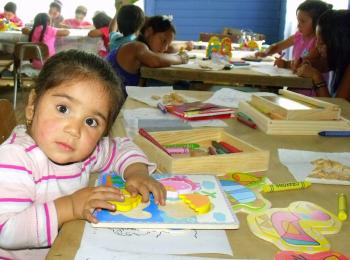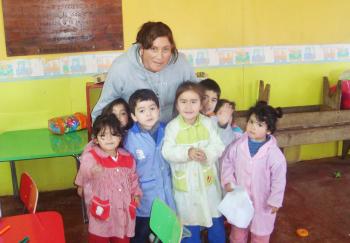The transition from emergency relief to sustainable community programmes

Keeping children busy after the earthquake (photo: SOS archives).
In 2010, a massive earthquake measuring 8.8 on the moment magnitude scale hit Chile. Its epicentre was only 60 km north of Concepción and, according to Chile’s Seismological Service, Concepción felt the violent effects of the quake most severely – the city was moved three metres to the west. An estimated nine per cent of the Chilean population, and over 17 per cent of the population in the BiobÃo region, lost their homes due to the earthquake and the ensuing tsunami.
In the aftermath, Concepción was something of a lawless city, with looting and rioting despite the heavy military presence. SOS Children’s Villages provided emergency relief, such as food, clothing, and basic hygiene products, to around 280 families, as well as offering emotional support. These emergency programmes were then gradually turned into self-sustainable development programmes run by the community itself.
Rebuilding does not just refer to infrastructure
The earthquake did great damage to the region’s infrastructure and the effects are far-reaching. The destruction of innumerable shops and companies meant that many employees were laid off – and some no longer even had a home to return to. It is sometimes referred to as the “social earthquake”.
Unemployment, contrary to the overall trend in Chile in recent years, was on the rise in Concepción in the year following the earthquake, with unemployment amongst women under the age of 34 almost double that of men. In early 2012, an estimated 67,000 people were unemployed in the city. Between 2010 and 2011 over 3,000 people left Concepción, migrating to other parts of the country in search of work.
Unemployment, contrary to the overall trend in Chile in recent years, was on the rise in Concepción in the year following the earthquake, with unemployment amongst women under the age of 34 almost double that of men. In early 2012, an estimated 67,000 people were unemployed in the city. Between 2010 and 2011 over 3,000 people left Concepción, migrating to other parts of the country in search of work.
What we do in Concepción

Children at the social centre (photo: SOS archives).
There is also an SOS Vocational Training Centre in Concepción, where future SOS mothers and staff are educated and prepared for the important roles they will take on within our organisation.
When young people from the children’s village are ready to leave their family in order to pursue further education or vocational training, the SOS Youth Programme provides shared accommodation for over 60 young people from the Children's Villages Bulnes, Concepción, Chaimávida, Coyanco and Puerto Varas. The young people come and live together here and, with the support of qualified counsellors, they can learn to take responsibility, plan their future and prepare for independent adult life.